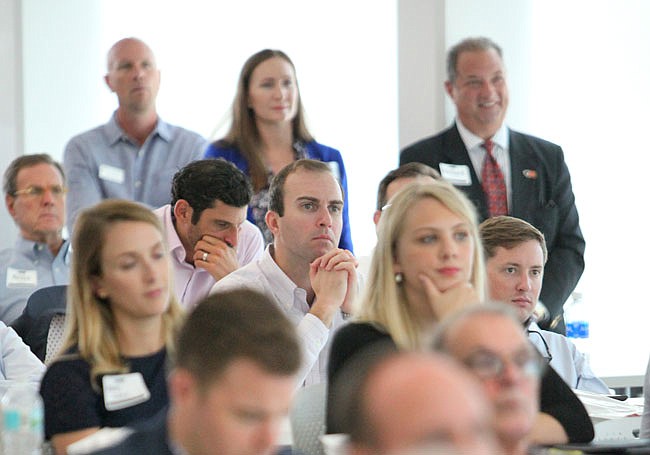It's good to be an industrial landlord or broker in the Interstate 4 corridor these days.
That was the overall message coming out of the I-4 Commercial Corridor Conference, a daylong event on Aug. 11 sponsored by Lakeland-based commercial real estate brokerage Coldwell Banker Commercial Saunders Ralston Dantzler.
“Our experience in the I-4 corridor is pretty incredible right now,” Julia Silva Rettig, a director at commercial real estate brokerage firm Cushman & Wakefield based in Tampa, told a few dozen of the more than 350 conference attendees at Florida Polytechnic University during a breakout session.
Strategically located between Tampa and Orlando, distributors in the corridor can reach as many as 18 million consumers within a day's drive — making it among the most important sites in Florida to transport goods.
It's why Amazon, Walmart, Publix Super Markets Inc., Southern Wine & Spirits and a host of others have established massive fulfillment centers there, moves that have driven up absorption and rental rates while shaving vacancies.
Rettig, whose firm is leasing McCraney Property Co.'s County Line Logistics Center, notes that even with more than 1,100 industrial buildings in the corridor, industrial vacancy remains at 6.3%.
Those dynamics also are why developers such as McCraney, Duke Realty, Brennan Investment Group, Central Florida Development, Flagler Development and Prologis — one of the nation's largest industrial real estate owners — have bought land for new projects to accommodate a raft of large users hoping to join the mix.
David Murphy, a senior vice president with commercial real estate firm CBRE Inc., notes that in 2012, there was a lone user seeking 500,000 square feet of space in the corridor.
Today, there are at least seven firms of that same size scouring the I-4 market.
“Everything is working in favor of industrial right now,” Murphy says. “Amazon changed what happened in the marketplace, but today, they're not the only ones driving the train.”
E-commerce giant Amazon operates a pair of 1 million-square-foot fulfillment centers in the corridor, in Lakeland and Ruskin.
Brandon Dedekind, a Prologis vice president, says that its portfolio of roughly 5 million square feet of industrial space in Central Florida is 93% occupied — and that the 7% that is vacant is located in just three buildings.
“That shows how tight the market is,” he says.
That tightness has prompted Flagler to deliver more than 1 million square feet of new industrial annually in each of the past four years, says Andrew Lehrer, the company's director of business development.
This year and in 2018, that figure is projected to jump to 1.5 million square feet.
Flagler's County Line Corporate Park is expected to contain as much as 8.5 million square feet of space when built out. Another development, the as-yet unbuilt Lakeland Central Park, is slated to contain another 5.5 million square feet, Lehrer says.
And while those figures may appear to offer a daunting amount of space — together with a multitude of other, similar projects in the works in the corridor — CBRE's Murphy says current macroeconomic trends may fuel future development for some time.
E-commerce, or online shopping, he notes, will soon be a $500 billion venture in the U.S., as the likes of Amazon continue to gain market share from traditional bricks-and-mortar retailers.
As online buying becomes more prevalent, so does the need for increased industrial space to distribute from, Murphy says.
For every $1 billion of e-commerce sales, he says, purveyors need 1.25 million square feet of fulfillment space — a staggering amount that dovetails with more direct shipping to consumers from warehouses.
At the same time, e-commerce distributors like Amazon also are experimenting with so-called “last mile” distribution channels that will require still more distribution facilities to meet customers' demands for goods faster.
Several e-commerce firms -- Amazon included -- also are toying with opening physical stores to provide customers with another way to access their merchandise.
So-called “clicks to bricks” retailing — think Amazon's purchase of the Whole Foods Market — also could have a profound impact on industrial real estate demand.
“Everybody today is only as good as their supply chain,” Murphy says.
Lehrer agrees, noting that distributors of all stripes today “want to be as close to the customer as possible.”
Amazon's Whole Foods purchase, and similar pushes into the $2 trillion food delivery market, may also spark a need for additional distribution product nationwide, Murphy says.
Today, only 2% of all food purchases are made online, he notes, leaving considerable room for growth. Some estimates say that online food shopping alone will prompt the need for 1 billion square feet of additional distribution space.
“Let's just say there's going to be a lot of demand for new freezer space,” Murphy told the attendees.
But while the I-4 corridor will likely continue to resonate with developers and distributors alike, some properties aren't suitable for new warehouse space — despite their prime center-state location.
“Not every piece of land is created equal,” Prologis' Dedekind says.
Richard LeFrois, whose Central Florida Development company is entitled to develop as much as 800,000 square feet of industrial space on a 100-acre tract in Lakeland, agrees.
“There's a lot of land available when you drive down the road, but a lot of it has problems,” he says. “It's getting much more difficult to find good sites.”






